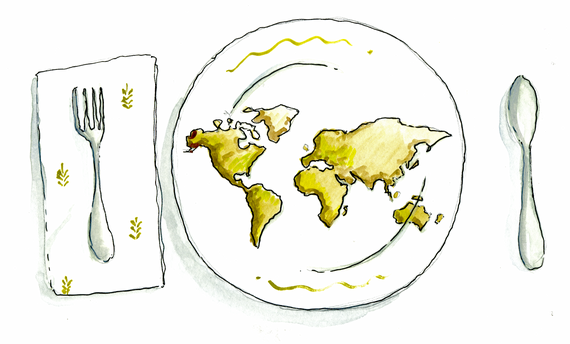"All of upper-Egypt was dying of hunger to such a degree that everyone had come to eating their children." - Inscription from the Egyptian Tomb of Ankhtifi, 2000 BC
Yikes! Happy World Food Day 2015! And to celebrate, how's that for an encouraging, inspiring quote from world history? Coming from a crypt it seems more fit for Halloween than World Food Day. Yet the facts are that If you are human, Ankhtifi's creepy quote echo's through history as a cautionary tale. Hunger is indeed humanities oldest and most persistent foe.
Evidently, hunger was a problem for the people of Ankhtifi's time, people who lived more than 2000 years before Christ. I'm not an Egyptologist, but it seems safe to say that eating ones children qualifies as less than idyllic times. Scholars think this comment is not necessarily to be taken at face value, but more likely a bit of hyperbole, either to impress the gods or inscription-readers to come like you and me. Those same inscriptions include many notes, perhaps embellished as well, of Ankhtifi's generosity in reaching out and feeding the hungry. Exaggerated or not, the fact that Ankhtifi found such a prominent place for the role of hunger on his hieroglyphic wall, is telling. People had plenty to be afraid of in those days, and hunger was apparently somewhere near the top of the list.
Perhaps more telling than ancient crypt inscriptions are the numbers about hunger that we know from later history. In the centuries ahead the death-toll of humans claimed by hunger gets even more bleak: In 1347 two thirds of Italy's population reportedly starved to death. From 1845-1850 the "great hunger" in Ireland claimed more than a million lives. 1919-1921 in Ukraine, hunger and famine killed an estimated 7 million. 1943-44 in Bengal and India hunger killed 4 million more. Then in 1958-62 an estimated 30 million people died in China from the same killer -- hunger! Disease might kill you quicker, but whatever hunger lacks in speed it makes up for in tenacity. It has humbled and demoralized and bullied we puny human for millennia. And while our scientific genius has made amazing progress against many diseases, as of World Food Day 2015 the call for us to focus our best efforts on feeding the planet in a thoughtful and sustainable manner is as urgent as ever. (For a thoughtful discussion on this issue and all things food-related check out Food Tank.)
But spending another World Food Day quoting dramatic statistics about hunger strikes me as less helpful and constructive than instead pausing to reflect on the more mundane reality that while every human must eat, not every human sees food in the same way. Ruby Payne, author of A Framework for Understanding Poverty, talks about the differences in the way the three basic socio-economic classes see food. According to Payne the poor see food and ask, "Is it enough?"; the middle class look at food and ask, "Is it tasty?"; the wealthy class ask, "Is it pretty?" Supply, flavor, and presentation. Three ways to see food for three economic classes.
Today about one out of every three people on our earth looks at food and asks, "Is there enough?" Some children see food only once a day, and many die (about one every ten seconds) from complications that arise from a basic lack of it! Even here in the U.S., the richest in the history of the world, as many as one in eight children go to bed hungry. Few if any actually starve to death, but you don't have to die to have food insecurity ruin your life and limit your future. Hungry kids can't focus on school work, drop out earlier, and end up stuck on a path to poverty. Moreover, poor people are often served food that is highly processed, mass-produced, inexpensive, and immediately accessible. Many poor in America, therefore, are obese, as fast-food and open-and-serve foods are what they purchase and given through distribution. We don't often recognize it as such, but this is actually malnutrition. A misadjusted, improper relationship with food that causes disease, limits futures and even, we are learning, diminishes mental capacity in the young.
For those of us in the middle class, few are the occasions where we obsess about presentation and how pretty our food is. Free from scarcity and unconcerned about presentation, we turn our food-focus to taste. The bad news for us is that sugar tastes great, and our demands for great taste have landed excess sugar in some form in almost everything we eat. Eat a regular non-whole grain bagel, for example, and with in about 20 minutes it's sitting in your stomach with no discernible difference (to your gut and body) than if you had chosen to eat a bag of skittles instead. Sugar in excess turns out not to be very good for humans. So this normal, healthy, "does it taste good" question is masked by pallets that only like the taste of stuff that isn't really very good for us. That's a problem if you care about life, because studies show that we are now raising the first generation of kids who are not likely to out live us. This truncated life-span is due almost solely to our choices around food and nutrition.
While the "is there enough" and "does it taste good" questions are certainly questions we have all entertained at times in our lives, perhaps it is this third area where we can learn the most. For those of us largely free from supply concerns and struggling with flavor concerns, maybe presentation offers us an opportunity? It most certainly does if presentation is about more than plating food in a beautiful way. Presentation, by definition is the process of offering something to an audience. It is typically a demonstration meant to inform, persuade, inspire or build good will. In that regard, a good chunk of the world looks at us this World Food Day, the land of "does it taste good" and "is it pretty" and wonders if we will look up from our full-plates long enough to consider them. "Is there enough?", they ask.
2015 World Food Day begs the question of what sort of demonstration or presentation we will make to feed not only their hungry bellies, but to inspire them with our good will. Ankhtifi wrote glowing tomb inscriptions about himself. If we step up for the hungry, others -- maybe even our enemies -- will write inscriptions about how we prevented or delayed ten's of thousands of trips to tombs by feeding them and their children. That's not a bad historical legacy to leave behind.
Mark Moore is co-founder and CEO of MANA Nutrition. This post is adapted from his book Nourish: A God Who Loves to Feed Us. World-Food-Plate Illustration by Dave Baysden.

